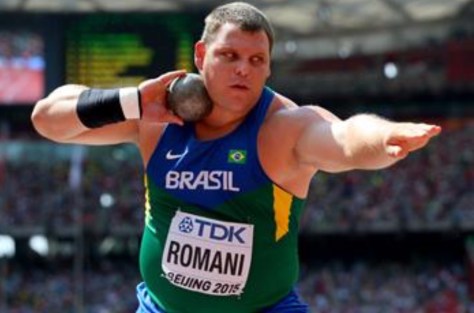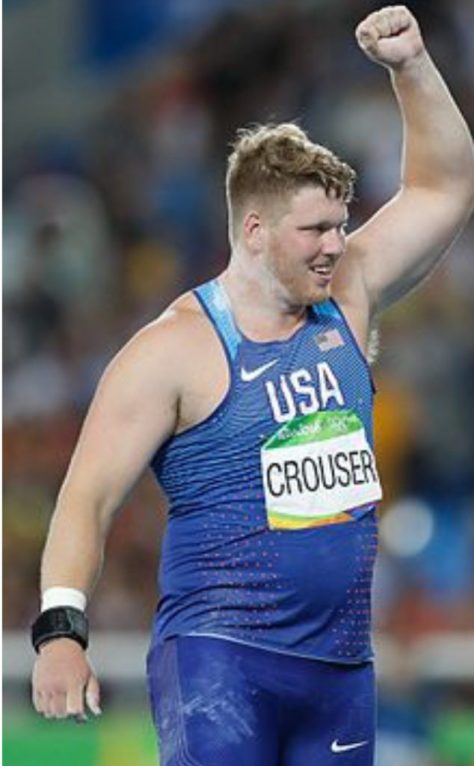
Self-doubt is antithetical to great throwing, especially when it starts to creep up in the moments before a big competition. To keep it at bay, many athletes rely on a warmup routine designed to calm the nerves while limbering up the joints.
One of the best parts about attending a meet like the 2019 USATF Outdoor Track and Field Championships is that you get to watch the athletes go through those routines.
As mentioned in a previous post, Joe Kovacs used the warmup period prior to the men’s shot to unleash a series of ferociously passionate throws. Power positions. Step and throws. Fulls. All launched with maximum effort.
It was an impressive display, and it worked. Dropping bomb after bomb near the 22-meter line in warmups put him into the mental and physical state he needed to go 21.99m, 22.00m and 22.31m during the first three rounds of competition.
It also may have drained him a bit, as his final three throws of 21.28m, 21.43m, and 21.39m seem to indicate that he became fatigued. But, who cares? Every thrower’s job is essentially to produce one great throw in competition and that’s what he did.
Ryan Crouser also produced one great throw on Friday, going 22.62m in round five.
But he took a very different approach in getting himself ready for the competition. He began with power positions, then launched quite a few full throws, but I didn’t get the impression that he put one hundred percent effort into any of them, even the ones that travelled nearly twenty-two meters.
I’d argue, in fact, that his first three competition throws (a foul, 21.91m, 21.93m) were just a continuation of his warmup. He spent more time tinkering with his rhythm during the additional warmup period between prelims and finals, and finally when round five rolled around he was ready to hammer one.
Valarie Allman demonstrated a totally different approach prior to the women’s disc. Her entire warmup consisted of two full-out full throws, and that was it. A few minutes later, she drilled a first-round 64.34m that would turn out to be the winning throw.
Probably the most interesting warmup period of the entire weekend, though, came prior to flight two of the women’s shot.
Rain started falling at the end of flight one, and it picked up in intensity as the ladies of the second flight lined up to take practice throws.
Before long, it was pounding down and the competitors started draping themselves in towels and jackets while waiting for their turn in the ring, which quickly became slick enough that one of the throwers face planted over the toe board on her follow-through.
The timing could not have been worse for Chase Ealey, who over the course of the season has established herself as the best American putter. She was indoor national champion, and is the current Diamond League points leader in her event. On a normal day, she would be a lock to advance to Doha. But this is her first year as a rotational thrower, and competing in a wet ring in a high pressure meet would be a challenge even for the most grizzled veteran.
Speaking of which, I’ll bet Michelle Carter was glad her father had made her a glider each time she sloshed her way into that ring for a warmup throw. After two seasons hovering around the eighteen-meter range, she needed to get on the podium here and advance to Doha in order to get her career back on track, and maybe the rain would give her an advantage in a field full of spinners.
It turns out that one of those spinners, defending champion Maggie Ewen, was glad to see the rain, which is surprising because if anyone needed a confidence-building warmup followed by a confidence-building performance it was Maggie.
Her first year as a pro has been difficult. She split earlier this season with her college coach Brian Blutreich, and coming into this meet had shown no sign of the confidence and impeccable rhythm that allowed her to throw 19.29m to win the title last year.
But she hit a hammer PB of 75.04m on Saturday, and the possibility of inclement weather for Sunday got her thinking about her triumph in a rain-soaked battle for the 2018 NCAA discus title. So the skies opening up on Sunday may have actually helped Maggie dispel any doubts she had about her ability to get back on the podium in the shot.
In terms of their approach to warming up, all three of these ladies seemed to be most like Crouser. They all started with easy power position throws and built from there. None of them launched any bombs aside from a nineteen-meter-plus South African by Ealey which, come to think of it, is actually a bomb.
But as far as full throws go, I’d say Chase was a bit over nineteen meters, while Michelle and Maggie each dropped a couple in the mid-eighteen meter range.
All three were methodical and calm, and it turns out that once the competition began, all three were ready. Maggie opened at 18.14m, Michelle with 18.02m, Chase with 18.46m,
Maggie followed that up with a second-round 18.44m, then Chase basically sealed the win with a 19.56m bomb.
Michelle improved to 18.69m in round three, and with the rain pelting down and no other thrower able to establish any sort of rhythm, it looked like the medalists were set.
Finally, in round six Jeneva Stevens, whose best throw of the day to that point had been 17.70m, dug deep and launched one that must have made Maggie’s heart skip a beat. It turned out to be 18.36m, and Jeneva was left with the small consolation of being the only thrower outside of the top three to break eighteen meters.
I spoke with the three medalists afterwards. You can view Chase’s comments here, Maggie’s here, and Michelle’s here.
I also had a nice chat with Lena Giger the recent Stanford grad who finished seventh after throwing 17.35m out of the first flight. Lena is a very articulate young lady who is about to take the great leap from collegiate to professional. I, for one, am confident that she will flourish as she was born and raised in the great state of Illinois.
So that’s it for the 2019 Championships.
Much thanks to the athletes who put up with my hopefully not-too-inane questions, and to the folks at Drake and the USATF who ran a fantastic meet.
I hope that, in spite of the fabulous facility soon to open in Eugene, the Championships will return to Des Moines on occasion. If not, I will miss the kindness and cheerfulness of all the folks who volunteered their time to make this event happen.
I will also miss Jethro’s BBQ, where my friends and I spent hours after each day’s competition happily rehashing all the big throws
Finally, I’d like to give a shoutout to two fellows who I’ve had the privilege of working alongside in the interview room at Drake Stadium the past two years, Mark Cullen who writes for Track and Field News and runs a website called trackerati.com, and Erik Boal who covers meets for Runnerspace.com.
Their passion for and knowledge of our sport is truly breathtaking. I’ve seen them conduct an insightful interview with a thrower, then turn around and do the same thing with a distance runner or sprinter. It is a weird and wonderful sight to behold, and I hope to join them in reporting on next year’s Olympic Trials in Eugene.





















